Podcast
Questions and Answers
How does physical development influence other areas of a child's overall development?
How does physical development influence other areas of a child's overall development?
- It only affects perceptual skills.
- It operates independently, with no reciprocal influence on language acquisition or emotional expression.
- It primarily affects cognitive skills but has minimal impact on social interactions.
- It is interconnected with other areas, where advancements or delays in physical skills can influence cognitive, social, and emotional development. (correct)
Which of the examples describes cognitive development in action?
Which of the examples describes cognitive development in action?
- A child learning new words.
- A child sharing toys with a friend.
- A baby smiling at the sound of their mother's voice. (correct)
- A toddler kicking a ball across the yard.
Why is it important for educators and caregivers to understand child development theories?
Why is it important for educators and caregivers to understand child development theories?
- To strictly adhere to standardized testing protocols.
- To diagnose developmental delays and prescribe medical treatments.
- To compare children's progress against their peers.
- To create experiences and environments that are developmentally appropriate and support children's progress. (correct)
What is the relationship between a caregiver's responsiveness and an infant's social and emotional development?
What is the relationship between a caregiver's responsiveness and an infant's social and emotional development?
How does singing songs like 'Row, Row, Row Your Boat' contribute to a toddler's development?
How does singing songs like 'Row, Row, Row Your Boat' contribute to a toddler's development?
An infant learning to crawl is an example of physical development, but how does this skill also support perceptual development?
An infant learning to crawl is an example of physical development, but how does this skill also support perceptual development?
Why is a solid understanding of child development crucial for creating effective curriculum and learning environments?
Why is a solid understanding of child development crucial for creating effective curriculum and learning environments?
What are the main domains of development?
What are the main domains of development?
How do repetitive movements, like an infant learning to crawl, affect cognitive development?
How do repetitive movements, like an infant learning to crawl, affect cognitive development?
During which stage of life do the most significant biological, psychological, and emotional changes occur?
During which stage of life do the most significant biological, psychological, and emotional changes occur?
Flashcards
Child Development
Child Development
The way a child grows and learns, encompassing physical, cognitive, language, and social-emotional aspects.
Physical Development
Physical Development
Advancements and refinements of motor skills, involving the growth and skill development of the body (brain, muscles, senses).
Cognitive Development
Cognitive Development
Learning and reasoning, including memory, symbolic thought, and problem-solving skills.
Social-Emotional Development
Social-Emotional Development
Signup and view all the flashcards
Language Development
Language Development
Signup and view all the flashcards
Domains of Development
Domains of Development
Signup and view all the flashcards
Why Study Child Development?
Why Study Child Development?
Signup and view all the flashcards
Stages of Childhood
Stages of Childhood
Signup and view all the flashcards
Child Development theories
Child Development theories
Signup and view all the flashcards
Child Development
Child Development
Signup and view all the flashcards
Study Notes
- Child development is the process through which a child grows and learns.
- Physical development is connected to other areas of development, influencing skills that build upon each other.
- Early skills are the foundation for more advanced learning.
Physical Development
- Physical development connects to social and emotional development.
- Caregivers' smiles help infants feel safe and secure.
- Infants hear different words, which aids communication.
- Scooting and crawling helps infants measure the world around them.
- Repetitious movement stimulates brain cells and allows the infant to control cognitive processes like concentration and memory.
Social and Emotional Development
- Toddlers learning that they are cared for, important, and fun to be around.
- Singing songs like "Row, Row, Row Your Boat" provides opportunities to hear and learn words, building communication skills.
- Moving up and down while singing helps children learn about patterns and sequencing, which builds early math and reading skills.
Domains of Development
- Domains refer to specific aspects of growth and change.
- The major domains of development are:
- Physical
- Cognitive
- Language
- Social-emotional
- Physical development is the advancement and refinement of motor skills.
- It involves a child's ability to use and control their bodies and relates to the growth and skill development of the body, including the brain, muscles, and senses.
- Cognitive development involves learning and reasoning, including memory, symbolic thought, and problem-solving skills.
- Examples include imitating an adult, making a "woof" sound when seeing a dog, or smiling at a familiar voice.
- Social-emotional development includes experiencing, expressing, and managing emotions and forming relationships.
- Language development is the process by which children understand and communicate.
Why Study Child Development?
- Child development theories provide a foundation for planning for groups of children.
- Knowing what is typical at a certain age informs the planning of experiences and environments.
- It provides a starting point for planning for a new child by assuming the child will benefit from experiences planned for typically developing children of their age.
- Understanding child development helps plan next steps for supporting children’s progress and setting achievable learning goals.
- It enables providers to create curriculum and environments that align to state standards.
- Knowledge of child development gives teachers confidence in their practice.
- Childcare providers who expand their knowledge of child development and learning can feel confident about their practice.
Stages of Childhood
- Child development includes biological, psychological, and emotional changes from birth to adolescence.
- Childhood is divided into three stages:
- Early childhood
- Middle childhood
- Adolescence
Studying That Suits You
Use AI to generate personalized quizzes and flashcards to suit your learning preferences.




